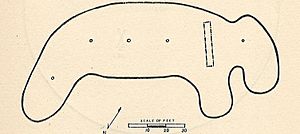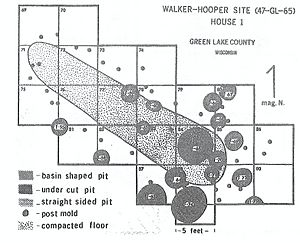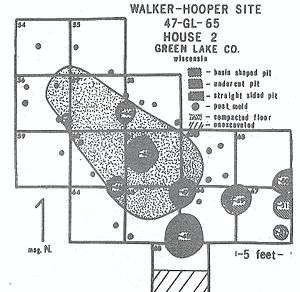Walker-Hooper Site facts for kids
Quick facts for kids Walker-Hooper Site (47-GL-65) |
|
|---|---|
 |
|
| Location | in Green Lake County, Wisconsin |
| Area | 60 acres |
| Lua error in Module:Location_map at line 420: attempt to index field 'wikibase' (a nil value). | |
The Walker-Hooper Site (also known as 47-GL-65) is a very old place where people used to live a long, long time ago. It's located in Green Lake County, Wisconsin, near the Grand River. This site has remains from different time periods, showing that many groups of people lived there.
Archaeologists found at least two old village sites and several groups of burial mounds. Sadly, these mounds are now gone. Experts from the Milwaukee Public Museum first explored the site in 1921. Later, in 1967, Guy Gibbon from the University of Wisconsin–Milwaukee did more digging.
The most important part of the site is a large village from the Upper Mississippian culture called Oneota. This village was protected by a strong wooden fence, known as a palisade. Other groups also lived here, including people from the Woodland period (Early, Middle, and Late) and even older groups from the Archaic period.
Contents
What the Area Looked Like
The Walker-Hooper site is in a region called the Carolinian Biotic Province. This means the environment around the site had a mix of different natural areas. There were open prairies, thick oak-hickory forests, and wet marshlands. These different environments would have provided various resources for the people living there.
Discoveries from 1921 Digs
The first excavations in 1921 mainly focused on the burial mounds. There were at least six groups of mounds at the site. Archaeologists found a total of 38 human burials. One very special mound, Mound 1 in Group 4, was shaped like a bear. This is called an effigy mound.
Most of the adults were buried with their knees bent (flexed position). The children and babies were usually buried stretched out (extended position). Some burials had special items with them, like pottery pots and other tools. Some graves even had charcoal, which suggests that fires were part of the burial ceremony.
Besides the mounds, archaeologists also dug up several "camp sites" and trash pits. These pits contained animal bones, broken pottery pieces, shell fragments, and tools made of stone and bone.
Here are some of the cool things found in 1921:
- Stone tools: Only one projectile point (like an arrowhead) made of quartzite was found in a burial. Other ground stone tools included an adze (a cutting tool), a spade, and pieces of celts and axes.
- Bone and antler tools: These included a bear tusk pendant, bone awls (for piercing), bone beads, a harpoon, fish hooks, and antler tools for making stone flakes.
- Shell items: Pendants made from unio shells and shell spoons were also found.
- Copper items: People also used Copper. They found a bracelet, beads, a pendant shaped like a serpent, an awl, and a celt made of copper.
Discoveries from 1967 Digs
The 1967 excavations uncovered some exciting things. They found two lines of holes where wooden posts once stood. These were the remains of a palisade, a strong fence that protected the village. They also found two oval-shaped houses and areas where trash was spread out.
There were 66 pits used for storage or trash. These pits contained many cultural items like broken pottery, stone flakes from tool making, and animal bones. The houses were about 35 feet long by 10 feet wide, and 20 feet long by 11 feet wide. Similar houses at other sites were a bit larger. The storage pits were found both inside and outside the houses.
Here are some of the artifacts found in 1967:
- Chipped stone tools: This included 93 projectile points (mostly triangular Madison points), wedges, gouges, notched flakes, gravers, and various types of knives and scrapers.
- Ground stone tools: They found 16 hammerstones, an anvil, grinding stones, and tools like hoes and adzes. Some decorative items like pendants and paint stones were also found.
- Bone and antler tools: Many tools were made from animal bones and antlers. These included antler projectile points, deer tine flakers, beaver incisor chisels, bone punches, and various types of awls made from deer bones, canine bones, and bird bones. They also found deer jaw sickles and bone tubes.
- Shell items: Shell was used for fishing lures, scrapers, and spoons.
- Copper items: Four copper pendants were found.
- Pottery and clay: They found 12 pottery discs, a clay spoon, a broken clay smoking pipe, and a clay ear spool.
The Grand River Oneota People
The Walker-Hooper site is very important for understanding a group of people called the Grand River Focus of the Oneota culture. This group is known for its unique pottery. Their pottery often had plain surfaces with very little decoration, except for the edges. Handles were also very rare on their pots.
The Grand River Focus, along with other groups like the Koshkonong and Green Bay Foci, are part of the "Developmental Horizon" of the Oneota culture. This period dates from about A.D. 1000 to 1300. Tests on materials from the Walker-Hooper site show that it was used between A.D. 1200 and 1240.
Archaeologists believe the site was used for a relatively short time. Based on the animal and plant remains found, it was likely a summer village where people grew crops.




